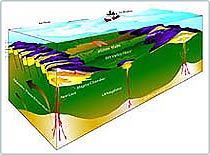Serpentine Stone: Potential risk of earthquakes
A relatively soft, dark green layer called Serpentine covering tectonic plates can play an important role in horrifying earthquakes, according to research by French and American scientists.
 Serpentine formed deep in the ocean long, about 200 km from the sea surface. It is the site of the most dangerous earthquakes on earth, including a 9-magnitude quake that triggered a catastrophic tsunami off Indonesia in December 2004.
Serpentine formed deep in the ocean long, about 200 km from the sea surface. It is the site of the most dangerous earthquakes on earth, including a 9-magnitude quake that triggered a catastrophic tsunami off Indonesia in December 2004.
According to a December 21 issue of Science, this soft rock layer can be formed on the ocean floor and also present in areas of high risk of volcanic earthquakes such as the Caribbean Sea and Japan. The rock in the seabed is usually hard but can be converted to flammable liquid under extremely high temperature and pressure conditions.
Scientists from Lyon University's CNRS laboratory also studied this problem and found that the upper layers of rock could break during the process of tectonic plates moving in ice-free waters land.
- The secret inside the Sun Pyramid
- Many big cities in Vietnam are at risk of earthquakes
- Japan has the risk of picking up earthquakes of 8 Richter scale
- Why did buildings collapse when the earthquake struck? The truth is more complicated than you think!
- Earthquakes caused many local shakes in Thua Thien Hue
- Vietnam is facing a high risk of earthquakes
- Expert warns of the risk of earthquakes and tsunamis in the South China Sea
- New warning about the potential risk of sleeping pills
- The risk of tsunami earthquakes affects Vietnam
- Recreate earthquakes in laboratories
- Earthquake due to ... urbanization
- Earthquakes continuously shook northeast China
 Is the magnetic North Pole shift dangerous to humanity?
Is the magnetic North Pole shift dangerous to humanity? Washington legalizes the recycling of human bodies into fertilizer
Washington legalizes the recycling of human bodies into fertilizer Lightning stone - the mysterious guest
Lightning stone - the mysterious guest Stunned by the mysterious sunset, strange appearance
Stunned by the mysterious sunset, strange appearance